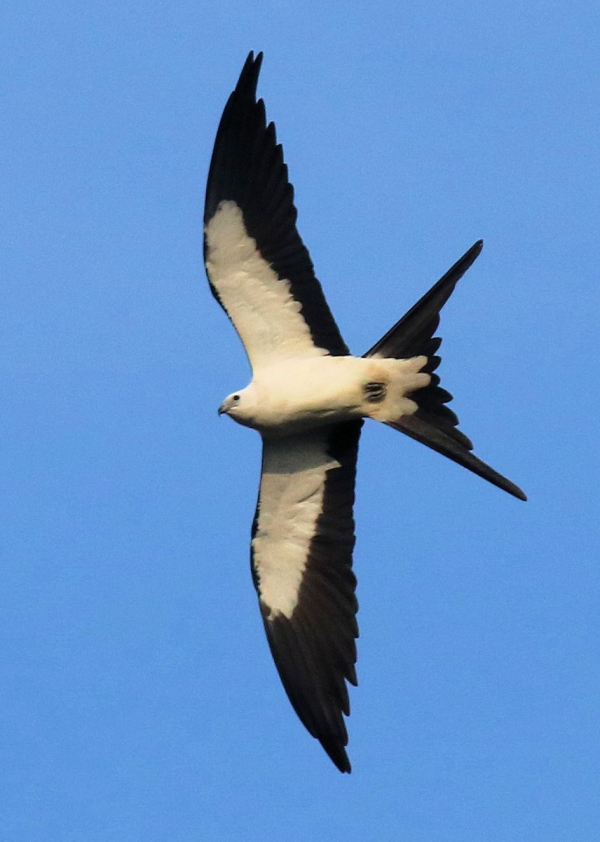
One of the best photos of a Swallow-tailed Kite banking shows little shadow on the underside.
|
As March progresses I always recall the thrills of photographing a spring migration of Swallow-tailed Kites when these elegant birds of prey sliced the sky like angels on the wing, maneuvering their forked tail in the breeze to rudder their buoyant flights. The kites’ movements appeared so effortless and graceful that they captured my attention as soon as I watched the first one in flight. Although Swallow-tailed Kites were scattered across Florida at the time, I found the best location to photograph Swallow-tails was deep in the Everglades.
I spent three nights camped on the southern tip of Florida, on the coast just beyond the south end of the access road that winds through Everglades National Park. During daylight hours I photographed a variety of wildlife while concentrating on the kites that were always in fluid motion (I never saw a Swallow-tail land during my entire trip).
Try & Try Again
Although I thought I took a wide variety and ample quantity of kite photos during my Everglades meanderings, when I reviewed my images in Tampa the day after leaving the ‘Glades, I realized I didn’t get “the classic Swallow-tailed Kite images” I was hoping for. All of my kite photos that showed the underside of the birds were creased by shadows, or the entire underside was shadowed, resulting in a gray underside instead of the true white coloration.
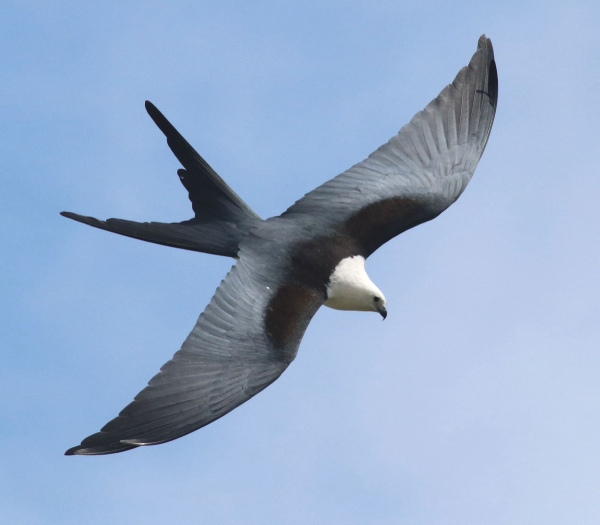
I became increasingly uncomfortable with the kite photo results, and I realized I needed to reset my plans after checking and re-checking the weather. With only one day of sun in the forecast for the week – tomorrow – I reversed course and returned to the depths of the Everglades – in spite of the mosquitos, biting flies, and no-see-ums that had already inflicted an itchy toll on me.
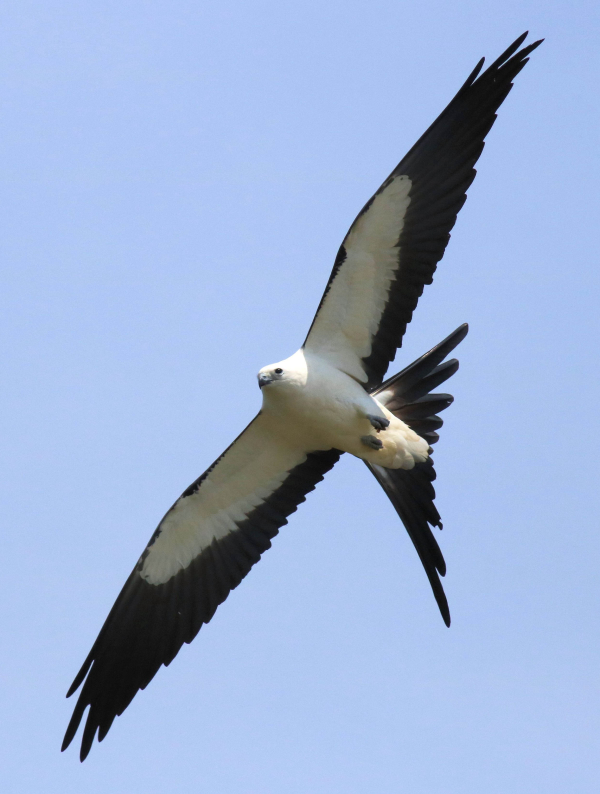
This photo shows the kite in a beautiful flight position, but the shadows compromise the quality of the image to discerning eyes. This was the best image from the first photo trip to the Everglades, prompting a return.
|
The next morning I photographed kites and other wildlife that I encountered in earnest in the Florida sunshine with the promise of rain clouds pending for that evening. About 11am, it became apparent that I was witnessing what turned into a marvelous spring flight of kites migrating inland from the Gulf, and for the next 100 minutes I observed and photographed more than 100 Swallow-tailed Kites as they followed meandering waterways line with trees.
The action was often fast-paced with kites flying by in small loose groups, and at one point 15 kites were within view. After more than an hour of avian action, I actually began to feel a bit exhausted by the excitement as I continued to focus on and follow the swift raptors through my camera lens as they seemed to revel in their undulating, circling, diving flights. What fun I had among the kites of the Everglades! And upon review of the resulting photos, my return to the kite hotspot yielded a number of classic images of kites slicing the sky.
Shadow Fights & Kite Flights
During kite photography sessions, fighting the unpredictable shadows that showed on the kites as they dipped this way and that on pulsing breezes was difficult. In fact, it was pretty impossible during my initial Everglades photo session. Luckily, I was able to make the return trip to work on beating the shadowy problems that plagued me. After reviewing my initial photos on the big screen, I assessed the situation, learned a bit from the review and photo editing process, and hoped I could improve my photos during my return to the southern tip of the Florida mainland.
Usually, just by limiting my photo time to periods when the light is best helps to eliminate problem shadows. By late March that means photographing during mornings and late afternoons. But when your time is limited, and the birds prove to be most active during mid-day, you must try to make the most of every minute in the field – especially if you only have fleeting opportunities to interact with the kites.
In the field it’s tough to judge how shadows will affect your photos. First, the birds are moving quickly and unpredictably. Second, we humans see shadows differently than they show up on digital photos. That is, shadows register quite a bit darker on a digital photo than they are perceived by our eyes and brain. If we see what seems like an inconsequential shadow, the shadow will be darker with greater contrast in the resulting photo image. Understanding that fact is very helpful across the bird photography spectrum.
So what’s the fix? Try very hard to avoid shadows, even as you photograph – just by being aware of shadows, and reacting during the quick action while photographing. If you do see shadows, or the effect of indirect light, wait for the bird to flare to one side or the other to get uniform sunlight to illuminate the bird without shadowing. And always be aware of the bird’s position with respect to the position of the sun and the direction of the sunlight. As I always say, be sure your shadow points toward your subject for the best results (keep your back to the sun when photographing birds).
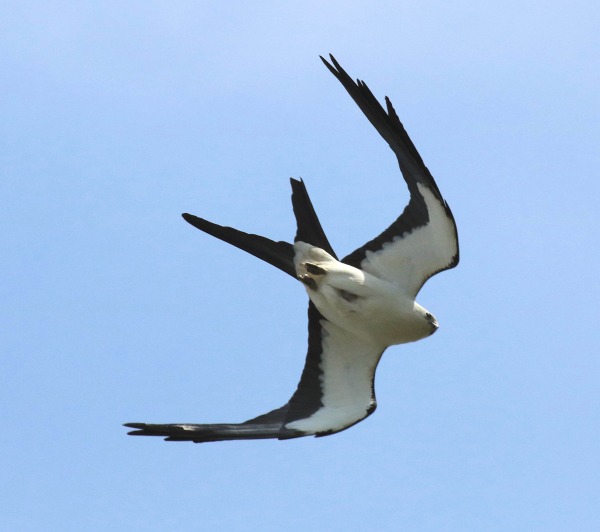
With a Little Luck
Take lots of photos – that’s part of the fun – and it helps to insure you will get the ultimate images you hope for. Use your continuous shooting mode setting, so you can take a rapid-fire series of photos too. This ploy can be good practice if nothing else, but it tends to help you get a selection of photos to choose from. Often we tend to press the shutter a fraction of a second after the action we wish to record, so try to anticipate a bird’s next move. In the end, while I photographed 100 kites in 100 minutes, I took more than 800 images – that’s some serious action photography. Ultimately, if you have the chance, take as many photos as you can. That way, even the “worst” photographer should get a few lucky shots! (ha-ha)
I really enjoyed that particular trip to Florida, but was surprised at how some of my favorite photo locations were poor choices at that time. For instance, Sanibel Island was a bust for any kind of photography, and that point emphasized the fact that the environs and birds on hand change with the seasons, with water levels, and other variables year to year – even day to day sometimes. However, the Everglades was the spot, and with ample water, it provided a few surprises along with many photo opportunities.
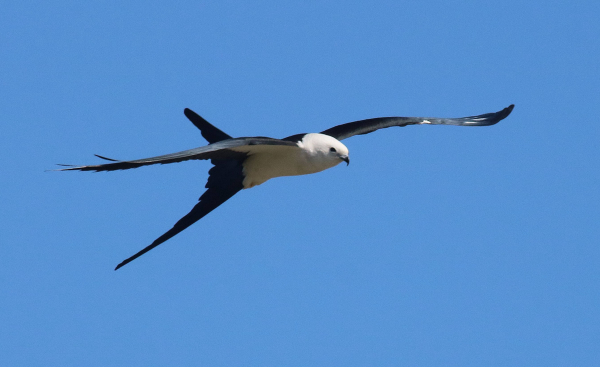
Everglades Surprises: A big Croc walked out of the swamp into a grassy opening that provided some exciting images head-on looking into its open mouth, and from the side showing its entire body. A similarly rather scary photo option was with a Water Moccasin, and while American Alligators were in almost every body of water, the rest of the exciting wildlife I encountered were birds – Wonderful Birds: White Ibis, Roseate Spoonbills, Wood Storks, Tri-colored Herons, Little Blue Herons, Anhingas, White-crowned Pigeons, a Pileated Woodpecker, a Red-shouldered Hawk, Black Vultures, Barred Owls, Fish Crows, and more.
The day after the kite migration, the rain began pouring as I was making my way north along the Atlantic Coast from Loxahatchee to Merritt Island. That’s when I got “The Call” to please return to Southern California to resume work east of Los Angeles, so I kept driving north to Jacksonville, turned onto Interstate 10 and drove west for too many days with short photo stops along coastal Texas and the Tucson area of Arizona. Nothing like travelin’ cross-country! But the moral of the story is to be aware of how shadows affect your photos, become more aware of shadows while you photograph, and keep your own shadow pointing toward your subjects. Good Luck!
Article and photos by Paul Konrad
Share your bird photographs and birding experiences at editorstbw2@gmail.com